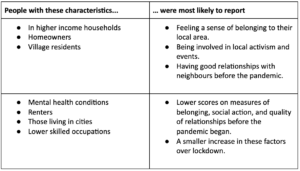Building community spirit where it matters most
The Royal Society for Public Health have produced an evidence-based tool to help communities across the country measure and improve their community spirit. In this guest blog, Florence Gildea talks about their Community Spirit Programme, and the effect of Covid-19 on community spirit.
Why we need to measure ‘community spirit’
According to the inverse care law, people who most need medical care are least likely to receive it, while those with the least need of health care tend to use health services more – and more effectively.
This law is well known to those working in the field of health and wellbeing. We also know that inequalities exist in how public health campaigns are received and understood, with those they are designed to target sometimes among the least likely to receive, understand and act upon such messages.
In these ways, our interventions may inadvertently increase health inequalities by improving the outcomes of those who already have the greatest material, social, and cultural resources to support their health.
The unequal impact of Covid-19 on community spirit
We surveyed 2,000 members of the public as part of our Community Spirit Programme to explore the effect of Covid-19 on community spirit.

For example, of respondents we surveyed who were unemployed, or in semi-skilled or unskilled occupations:
- 65% said they had never been involved in local activism.
- 46% said they had never been involved in social or leisure events in their community. This is nearly twice as many as those in the highest paying occupations, where the figure was 24%.
Given the health and wellbeing benefits that having a strong social network can bring, finding that community spirit is weakest among those groups with, on average, worse health outcomes, is especially concerning.
Going beyond a reliance on ‘Blitz spirit’
This means, as much as the Covid-19 outbreak may have inspired feelings of solidarity, our research highlights the fact that we cannot rely on the emergence of ‘Blitz spirit’ in times of crisis to spread the benefits of supportive communities to those who stand to benefit most.
We need policies which develop and sustain the economic, social and cultural lives of local areas, and we need grassroots initiatives which proactively engage as many members of the community as possible.
This is why RSPH, in partnership with Locality, and supported by the Health Foundation, developed an evidence-based toolkit to help community organisations, local authorities and community leaders to measure, improve and sustain their local community spirit.
What the toolkit looks like in practice
As we note in that toolkit, it may require creativity to engage those on the fringes of a community, as it is important to give people multiple ways to engage.
One fantastic example of this as part of our Community Spirit programme came from Darnall Well Being, a community hub in Sheffield. To find out what ‘community’ meant to local residents, the team set up a fishing net at a community allotment as part of a Covid-safe ‘Fun Palace’ day, where visitors could write their responses on paper luggage tags and tie them to the net. For those shielding and unable to attend the event, Darnall Well Being sent an activity pack which allowed people to respond in either their own words or with a picture.
These responses are all being compiled into a book while the fishing net and luggage tags have been kept in the local library’s archives so that the community, in a very real sense, has ownership of their own experience.
It can be tempting, as community organisations or leaders, to engage with those who are already highly active in civic and social action. But wherever the purpose is to bring the health and wellbeing benefits of community spirit, it is vital that our engagement efforts are genuinely inclusive, open, and accessible.
If you want further tips on how to do this as well as more general guidance for measuring, improving and sustaining community spirit, check out our Community Spirit Level framework and toolkit.
